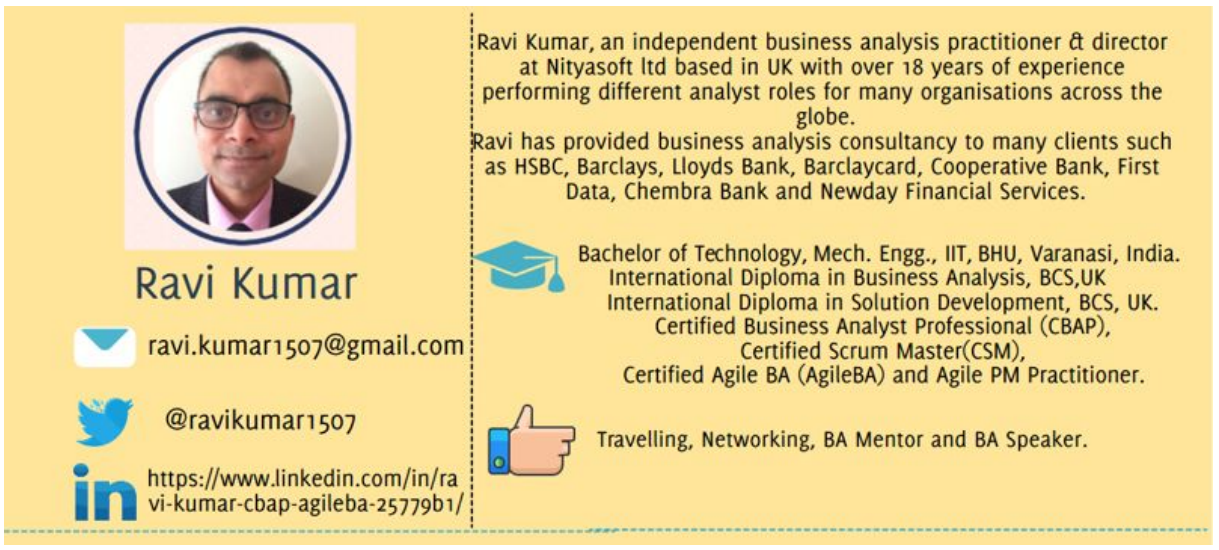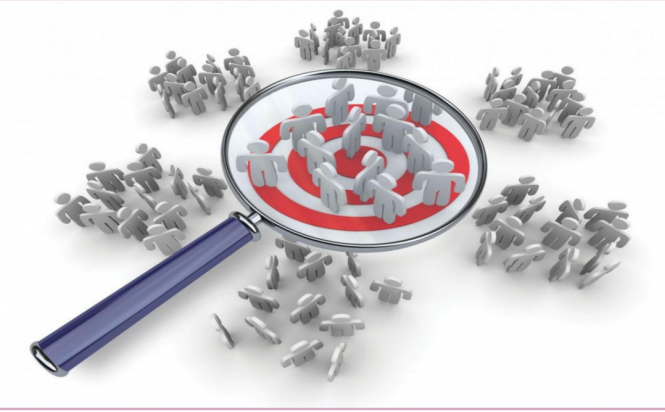
By Ravi Kumar
This article is to provide a brief and the essence of my talk I delivered on this topic at Europe Business Analysis Conference, London, September 25-27 2017 and Balkan Business Analysis Conference, Sofia, October 6-7 2017.
This is to emphasis why ‘Audience Analysis’ is crucial for embedding business change successfully and to further elaborate how this technique could be better performed in the context of business change implementation. Let’s start with a basic definition and aspects of Audience Analysis in perspective of public speaking.
Audience Analysis is a process for knowing your audience holistically i.e. demographically, psychographic and by using contextual/situational information. This is an enabler to convey your message successfully and to ensure it is relevant.
Demographic analysis helps to know who your audience are. Depending on your topic and message, some of the questions will be
relevant and some will not. For example – A talk about investment options would be very different if you are speaking with university students versus a group of retired people. So you would want to know age group.“Race, culture, or ethnicity” as this might impact your message, choice of language, gestures, and other aspects of your speech.
Psychographic analysis helps to discover what your audience may be thinking before and during your presentation. It covers both the knowledge (or lack of knowledge) and the beliefs of your audience. Are they neutral, or are they predisposed to agree with or oppose
your message? What are the most important values to the audience? (Or, what are the values of their organization?). It’s important to know what they value as these are often the best starting points upon which you can build your arguments.
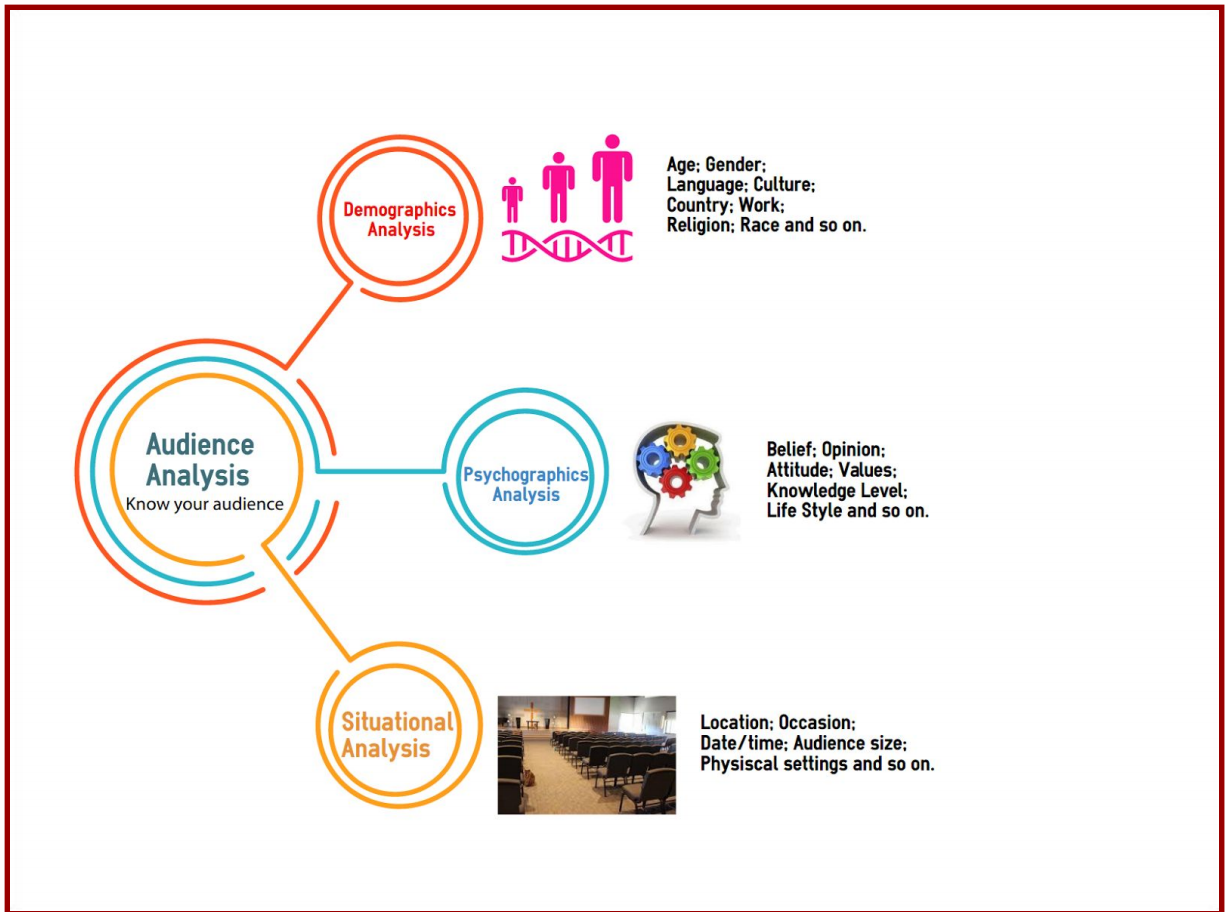
Situational/Contextual analysis helps to discover how the speaking event itself may influence your audience’s state of mind. Some of the questions needing answering are:
- When, where and why the event is happening?
- Is there any dress code?
- Timing /date and size of audience?
- What are physical settings at location?
- Is their attendance voluntary or mandatory?
- Why the audience is listening ?
- What has the audience been going through in the days or weeks prior to your speech?
- Have their been layoffs at the company?
Doing it well, audience analysis will provide insights that will help you focus your message, select the most effective content and visuals, and tailor your delivery to suit this particular target audience.
So finally I would say that doing a holistic analysis before an event helps to be better prepared, gain confidence and to ensure content is relevant.
Audience analysis shouldn’t stop before the event /speech, it must continue during and after the event.
During the event it is pertinent to observe the verbal and nonverbal responses, facial expressions, any restless movements in the audience and to make eye contact as much as possible to keep the right level of engagement with the audience. This will help to adapt to the audience as you speak. A good public speaker or keynote speakers are very good at knowing the pulse & mood of the audience and adapt their message based on real-time responses coming from the audience.
Audience analysis after the event aims to make improvements and to learn any lessons for future events. Find out how the audience felt about your speech, try to fetch verbal /non-verbal responses by talking to some of them after the event and conduct a survey to help to capture detailed feedback. Social media and online professional networks can also be used to get post event feedback.
The importance of nonverbal messages/cues is very high in public speaking or in general communication because if your words differ from your body language, the audience is more likely to believe your nonverbal cues (body language and tone of voice). Prof. Albert Mehrabian , professor of psychology at the University of California in Los Angeles did studies and research on the relative importance of verbal and nonverbal messages and in 1970 he came up with the below communication model to depict the relative impact of
words, tone of voice and body language on the listener. Pros Albert’s findings suggests that The non-verbal elements are particularly important for communicating feelings and attitude, especially when they are in-congruent, meaning not consistent : if words and body language disagree, one tends to believe the body language.
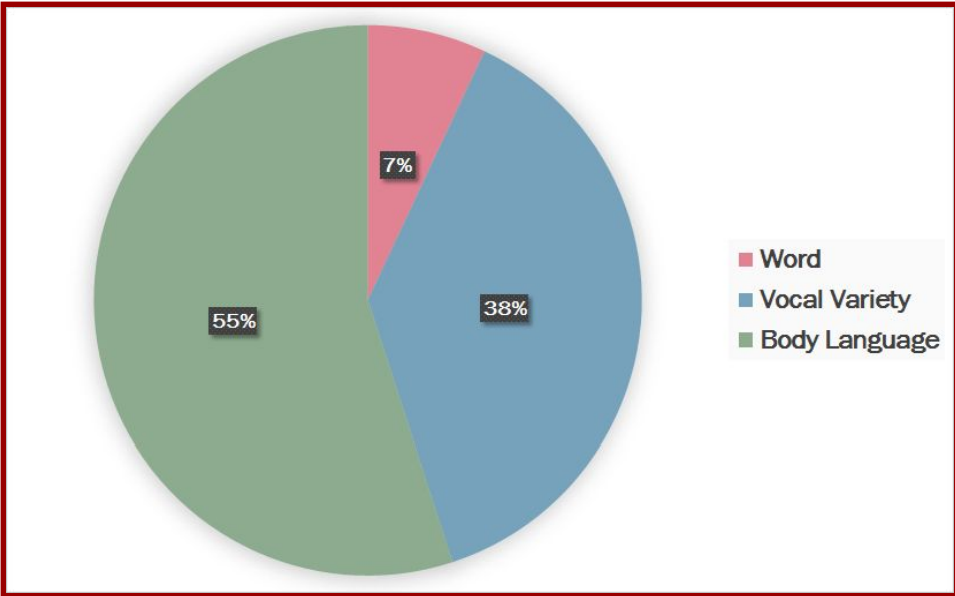
There is a popular story going around about the event when the American Presidential Debate was televised 1st time in the history on 26th September 1960 and it was between senator John F Kennedy and vice president Richard M Nixon. (John Kennedy was the
winner of that election). As per reported, people ,who watched the debate on television that night, thought the young Senator John F. Kennedy had won that night’s presidential debate. However people who heard the debate on radio thought Vice President Richard
M. Nixon was the clear winner. This highlights the importance of nonverbal cues a speaker shows in front of an audience to convey the message successfully.
During my research for this topic, I tried to find and interact with people who have been using this technique in their day to day work. Fortunately I got opportunity to meet and talk to Vince Stevenson (director at College of public speaking ) who has 35 years of experience in teaching and practising public speaking.
The following few tips I got from him:
- Avoid stereotyping – Stereotypes are fixed beliefs or opinions about people in a particular group. Stereotyping neglects individual differences and often causes people to make decisions based on flawed reasoning. The best way to avoid stereotyping is to learn as much as possible about an audience instead of relying on preconceived notions of a group. That’s where psychographic audience analysis elements talked earlier, can be a big help.
- It’s not what you say - it’s the way that you say it - I think his assertion resonate with what we talked earlier about in the Albert Mehrabian communication model on relative importance of nonverbal messages. Confidence and keeping your words in sync with your body language /expressions make a positive impact on the audience.
- Plan , prepare and practice – it helps in improving your speech delivery and getting rid of fear, anxiety or nerves of speaking, there is no substitute for this. Don’t let emotion overtake you.
Now let’s discuss why Audience Analysis is so important for Business Change?
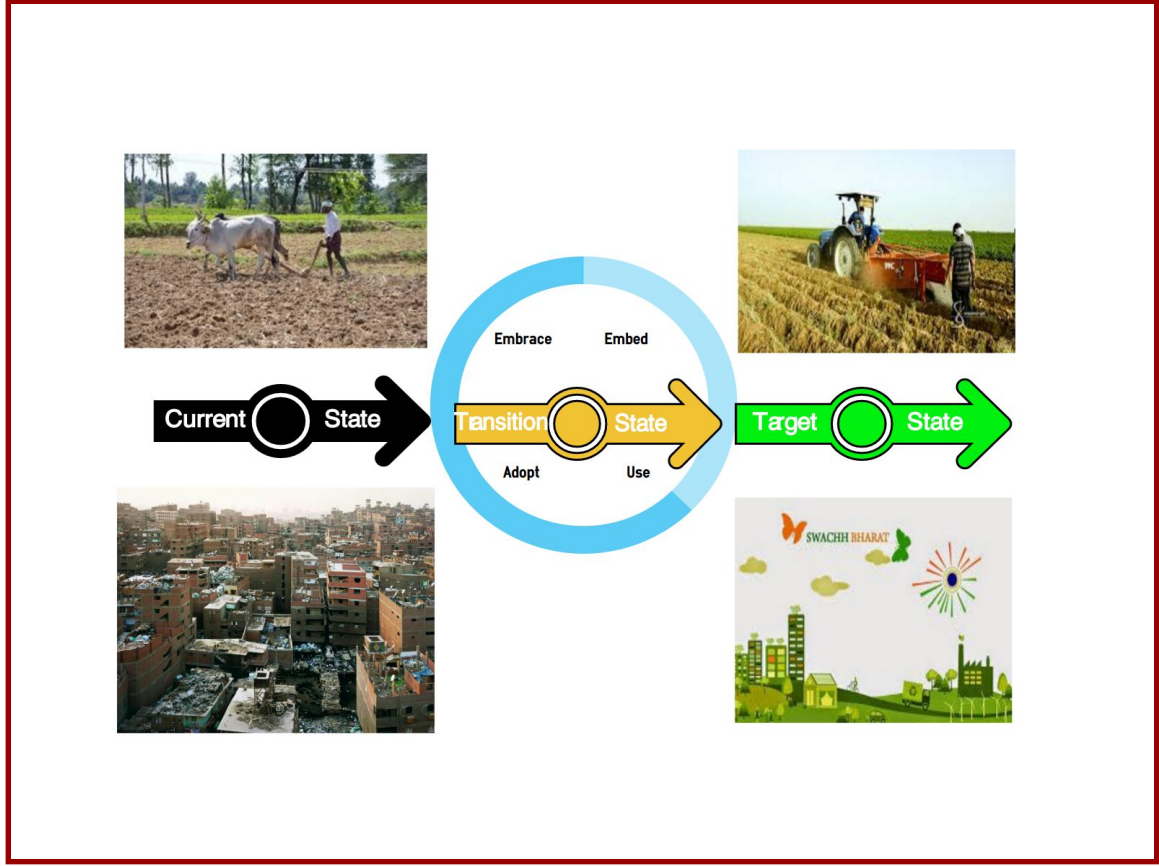
Business change involves transitioning the business from current state into target state by embedding and adopting the change. Embedding a change is not always easy. Managing the target audience by taking them through the change path is very challenging
and full of resistance. In my view Audience Analysis is essential to know who is impacted by the change and to understand their reaction towards it. This is to ensure through proper planning and activities that the intended audience is ready, willing and able to accept business change. What this means is we need to identify the best change interventions for each audience group so it helps them adopt the change faster and smoother as per plan. After all, adopting the change faster will realise your benefits sooner. Audience Analysis will help define the right change journey for the intended audience group so they are committed towards new change.
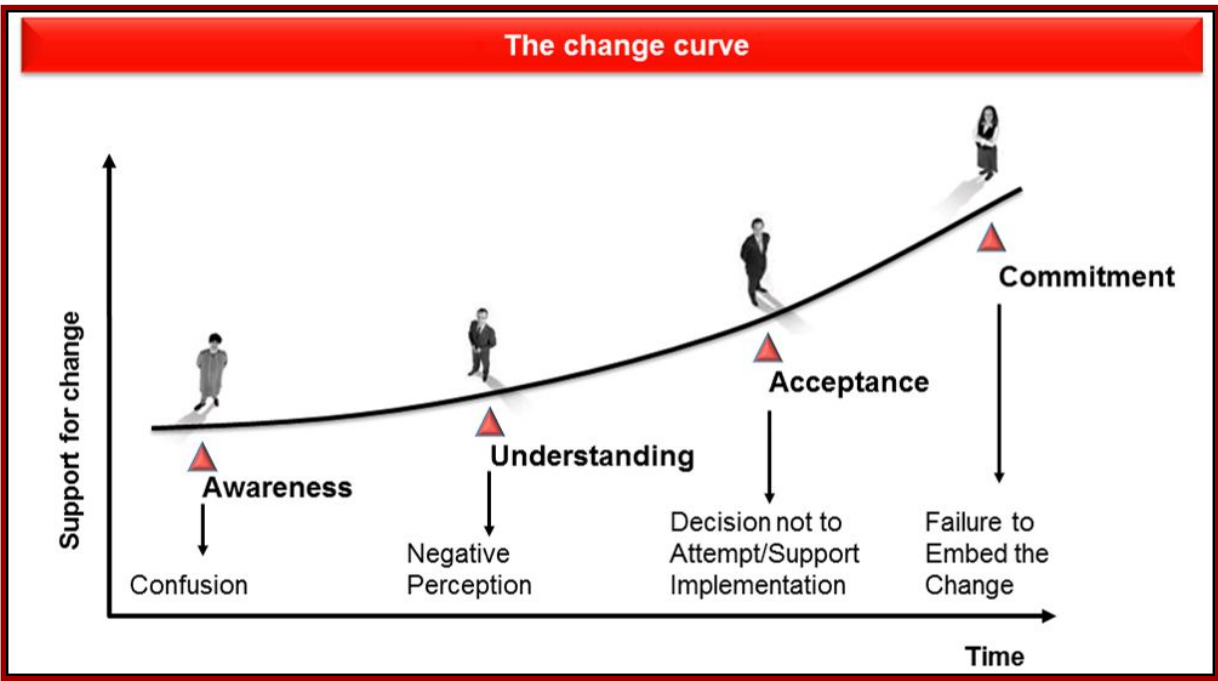
Any business implementation approach based on just feedback from a few key stakeholders, on old implementation documents, and without any detailed audience analysis is bound to create issues/problems whilst embedding the business change.
I have witnessed many such examples, one was a couple of years ago while working with a client. They rolled out a tool for requirements management with great fan fair , on the premise that it will resolve existing problems, improve efficiency, real-time integration with test manager and will provide a collaboration platform for stakeholder review and feedback. The management and leadership were very optimistic about the new tool and benefits it would bring to the business. However after 6-9 months , adoption rate by different teams at different locations was very poor and finally it was decided to go for some other requirement management tool.
Another example I was part of was a programme to launch a credit card processing platform for a bank. Even after launching the platform it took more than year to get fully utilised operationally as per expectation and initial benefit realization plan. Retrospectively looking back, I understand that lack of proper audience analysis was one of the key reasons for delay or failure of adoption of new change.
One of biggest UK Government programme failures was the NHS National programme for IT. The vision was to implement modern and world class information technologies to transform NHS service delivery and ultimately to enhance the quality of patient care. The programme comprised of a number of components including electronic appointment booking, e-prescription service and local care and a patient record system. The programme was started in 2002 by Tony Blair Labour government and in 2011 the Conservative government abandoned the programme. By this time 11 billion plus of taxpayer money was spent. So much has already been written and reasons talked about for its failure. One of of the many reasons was very poor adoption by end users at local NHS level.
How to Perform Audience Analysis for business change ?
Now let us look at how best we could perform audience analysis contributing to different activities /task required prior to actual business change implementation.
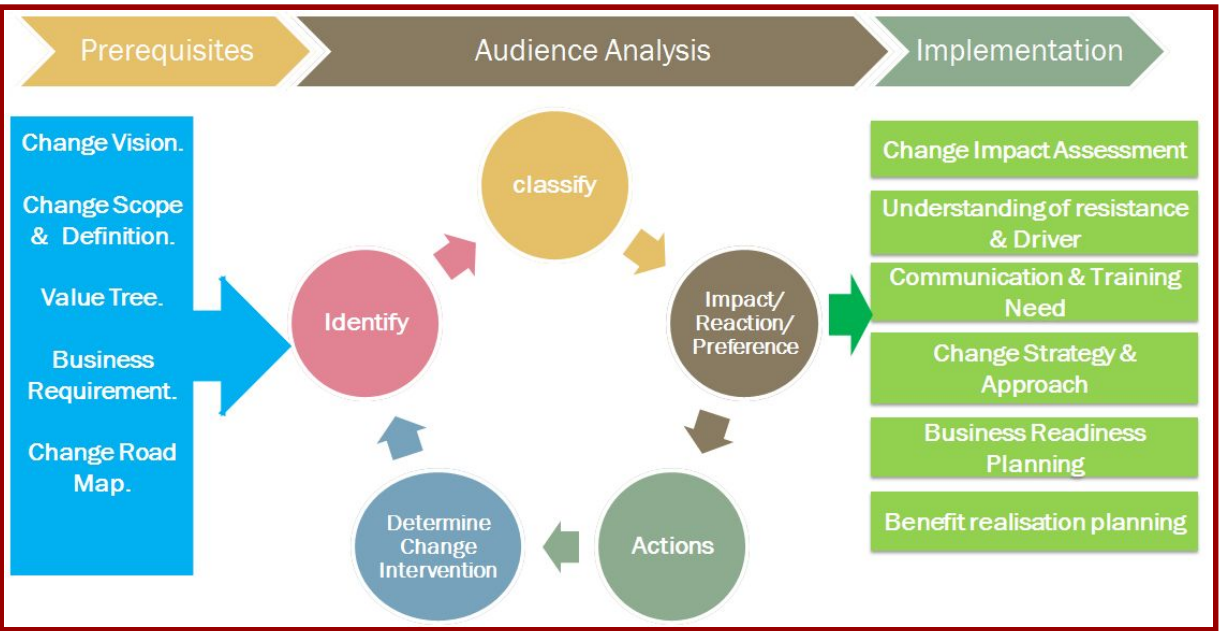
In the run up to business change implementation we need pre-requisites in place such as;
- Impact assessment;
- Understanding the drivers and resistance for change;
- Communication & training need analysis;
- Change strategy/approach;
- Implementation approach & planning;
- Business readiness planning;
- Benefit realisation planning etc.
For each of these pre-requisites impacted audience analysis is crucial. In my experience we carried out audience analysis as a parallel activity under business change implementation. Audience analysis is done in short iterations (few days or a week ) and in a continuous manner.
It can be broken down in 5 main steps before finally feeding them into the implementation approach and planning
- Identification
- Classification
- Assessing Impact/Reaction/Preference
- Assigning Actions
- Determination of change intervention
Some of the key prerequisites which helps performing audience analysis are:
- Change vision
- Scope definition
- Value tree
- Business requirement
- Road map change
Many times I find value tree or road map is missing. Value tree depicts a connection between vision, key benefits, key outcome and enablers. This helps steering different audience groups in the right direction and it helps with answering many queries and
questions.
If you don’t have road map even with an aspiration date it is difficult to establish the right level of engagement with different user or operational groups as they are involved with many initiatives and work on priority basis.
Pre-requisites are important to manage any queries /information needed from the audience group and to steer them in the right direction. This will also help them to be aware and build knowledge and understanding of change.
All of these steps could be done in one go in a workshop or can be done with different audience groups as you won’t be able to get all impacted audiences in one place or in one call.
Step 01 - Identify Audience
In the first step, you need to identify your audiences. You can do this by various of sources
some of which are described below.
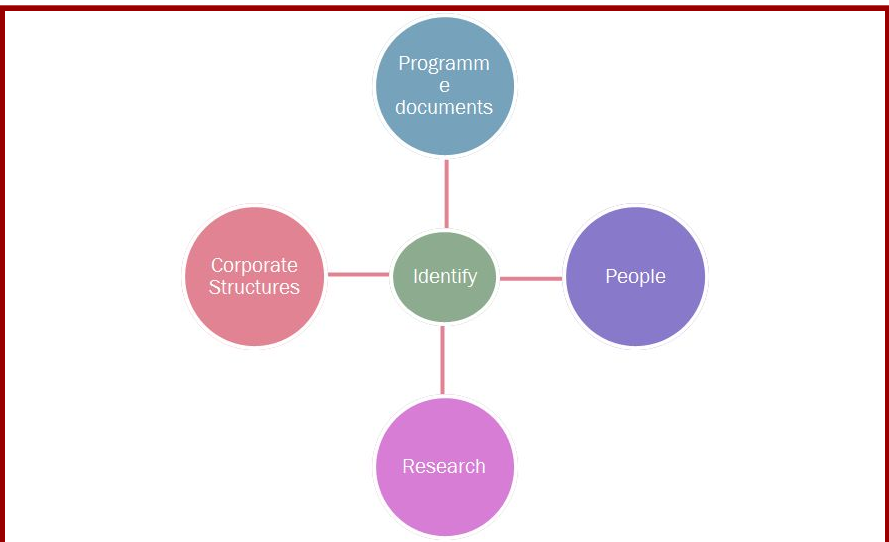
❖ Audiences can consist of any individuals and groups from inside and outside the organisation, who have an interest in or will be impacted by the change.
❖ Internally, they can be identified as a department, a team or other readily recognizable group.
❖ Externally, they could be your customers, suppliers, regulators and partners.
Here are few helpful tips about identifying your audience:
- Speak to the audience – engage in dialogue rather than relying on opinion / second hand views
- Do not rely solely on senior stakeholders for this information – your employees ‘on the ground’ know how things work and they will far better understanding of how the change will impact them.
- New audience group/team which is not in place. – due analysis and investigation required to confirm which department the new group would come under, what would be location and skill set , recruitment & team onboarding and scope of work. It takes considerable amount of time to get agreement around this, particularly if you are building specialised team. I had an such experience where we needed a specialised manual sanction screening team and implementation got delayed for many month because of delay in building the new team.
- Audience groups which are not directly impacted but provide guidance and control – such as compliance, customer experience, legal, risk, data and privacy , complaints , fraud, financial crimes, and so on so forth, they must be identified and engaged appropriately.
- External audience group - such as regulators, third parties , suppliers, vendors must be
identified and appropriately engaged.
Step 02 - Classify Audience
We need to group and classify audiences based on their needs and their change journey.
This activity will simplify your and implementation plans and approach.
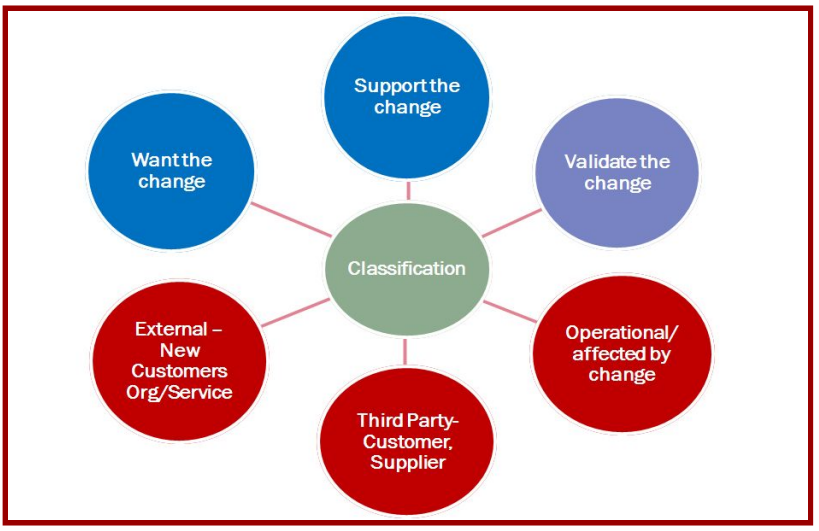
In my experience , we classify audiences by assigning a standard classifications about why they are part of your audience list. There are 6 standard classification to select from such as:
- want the change,
- validate the change,
- Support the change,
- operational affected by the change,
- third party,
- external groups.
You can select more than one option per audience.
In the diagram the blue circles reflect audience groups involved in the delivery and implementation of the change, say your Service Delivery team in their development role are “supporting the change” The red circles reflect audiences affected by the change , like your Customer receiving a new product or system. And sometimes , your audience could be part of both groups. For example you are rolling out internet banking solution which impacts your customers and help desk staff. Your Help desk staff will be involved in focus groups as part of “Validate the change “ classification but they will also receive the change as part of the “Operational affected by change” As you understand all audience group won’t have same level of impact and change journey and needed interventions would be different so classifying them and further subgrouping them help to execute and plan respective change intervention activities in tranches or
priority order.
Step 03 - Assess impact, reaction and preferences
Now we have identified, classified and grouped our audiences, we need to understand how it impacts them, their reaction to it such as resistance or positive /negative emotion and what would be their preference for change intervention. For example front line staff may prefer e-learning . This can be achieved by using analysing techniques such as a focus group, workshops, shadowing /observation and interviews. The element of demographic , psychographic and contextual analysis referred earlier come into play here which will help particularly knowing reactions (such as resistance, positive or negative emotion) and their preference for how they want to move on a change path.
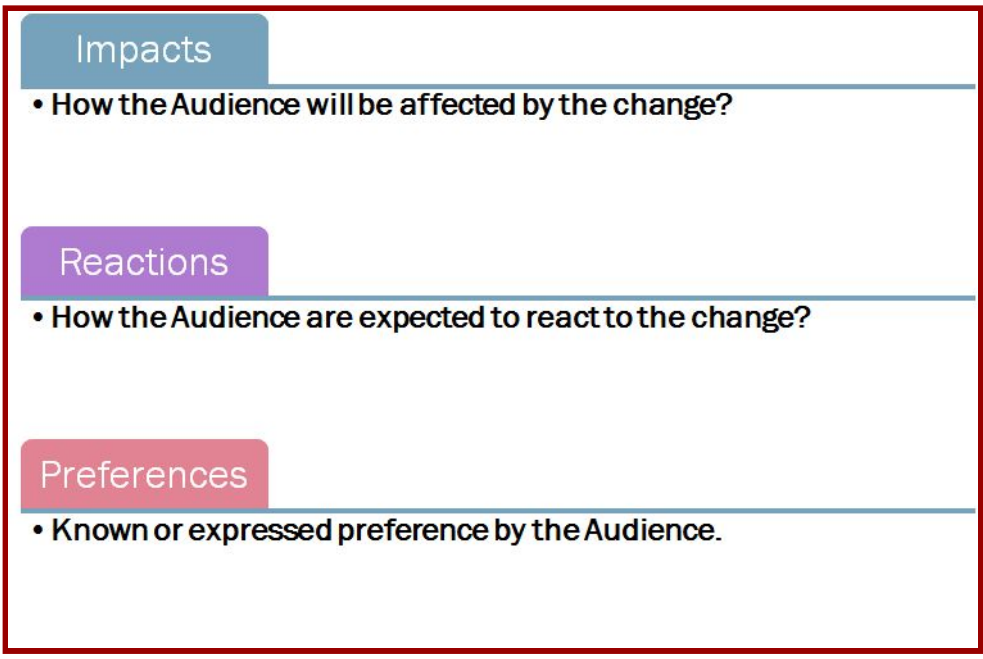
We need to gain an holistic view of impacts whether it Customer impact or Product, services, channels impact or People and organisation impact or Process and operation impact or System and data impact or Management and governance impact.
POPIT Model should be considered while doing impact assessment to gain holistic view.
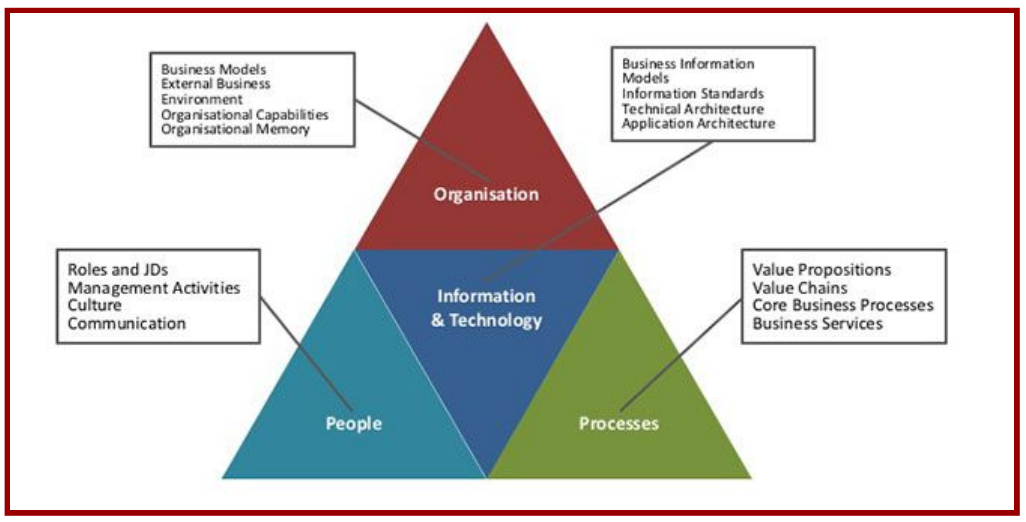
When there is strong focus on changing culture it is essential to carry out cultural web analysis to assess potential cultural challenges you may experience when driving the transformation change. Analysing, symbols, stories/myths, rituals/routines, control system, organisation structure, power structure help to have deeper understanding of belief, value and assumption prevailing in the organisation. Understanding the cultural barriers is the 1st step to identify potential mitigation and management activities.
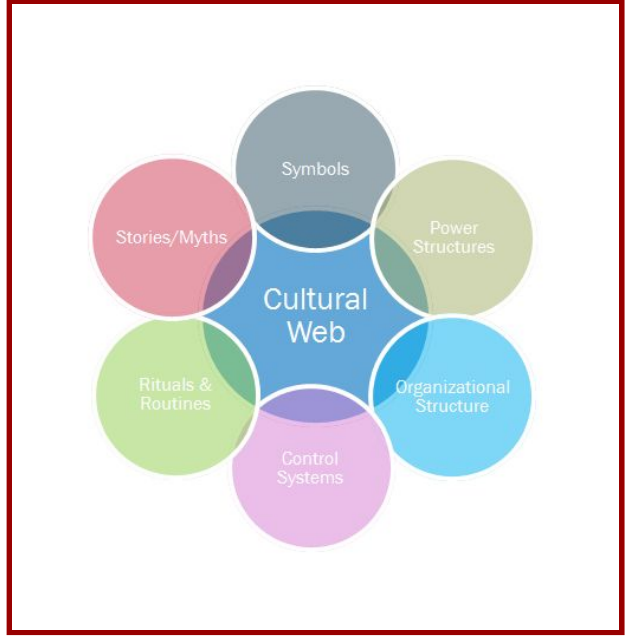
Operational Impact & Risks : It is imperative to assess and analysis impact on each aspect/component of Operational model as it would directly impact the audience group. We need to ensure that we didn’t overlook any component such as operation risk or metrics
etc.
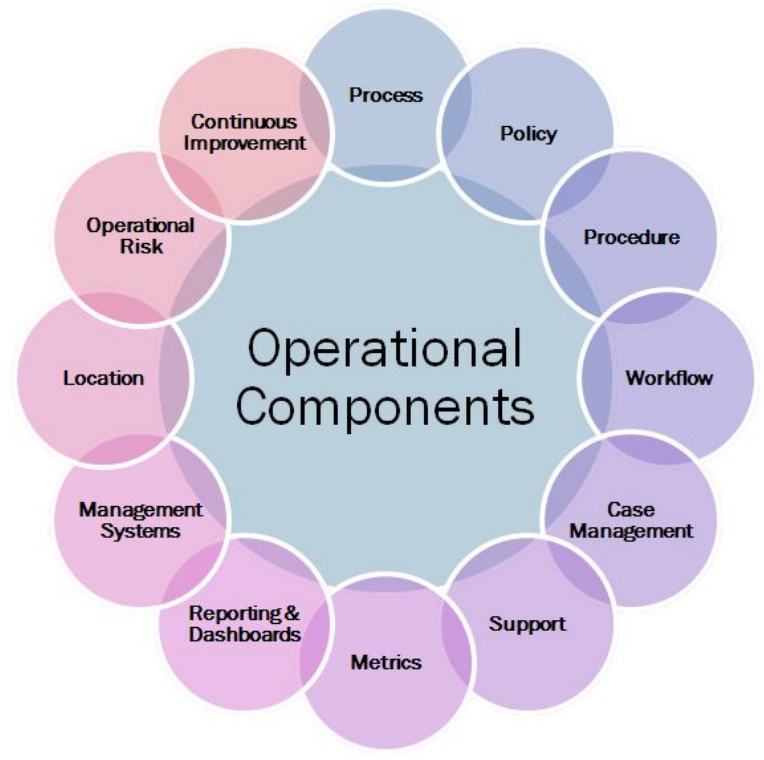
This will help in :
❖ Transitioning into target state with minimal impact on BAU business operations.
❖ To Reinforcing the new changes
❖ Ensuring responsibilities are clear and align to the change
❖ Define ownership of the change
❖ Define success factors and how it would be measured
Appropriate safeguard and control needs to be in place to deal with operational risks and minimise the impact when incidence. If mismanaged ops risk could lead to detrimental impacts to customer, reputation, regulatory standing and finance.
Operational risk “the risk of loss resulting from inadequate or failed internal processes, people , systems or from external events , including legal risk.” In 2015, operational system failure at Sainsbury’s bank left UK customers unable to access credit card or saving accounts for many hours. A similar incident happened at RBS in 2012 where thousands of customers were unable to make payment from their bank account. Process risk takes place when internal procedures or process fails. In 2014 , the FCA fined Standard bank around 8 millions £ for failings relating to anti-ML policies and procedures over corporate customer connected to politically exposed persons PEP.
People Risk arises from human errors caused by inadequate training and resources , poor supervision or from outright wrongdoing, such as fraud.
System Risk arises from flawed a or inadequate systems.
Operational risk could also occur from External event, natural disaster or Miss selling of
product.
Human Impacts and reactions: Reactions and emotional changes must be handled carefully. The impacted audience during the business change would go through different emotional change and reactions. These reactions are perfectly normal and expected so we
need to recognise them and devise strategy to support people while they are going through the emotional changes.
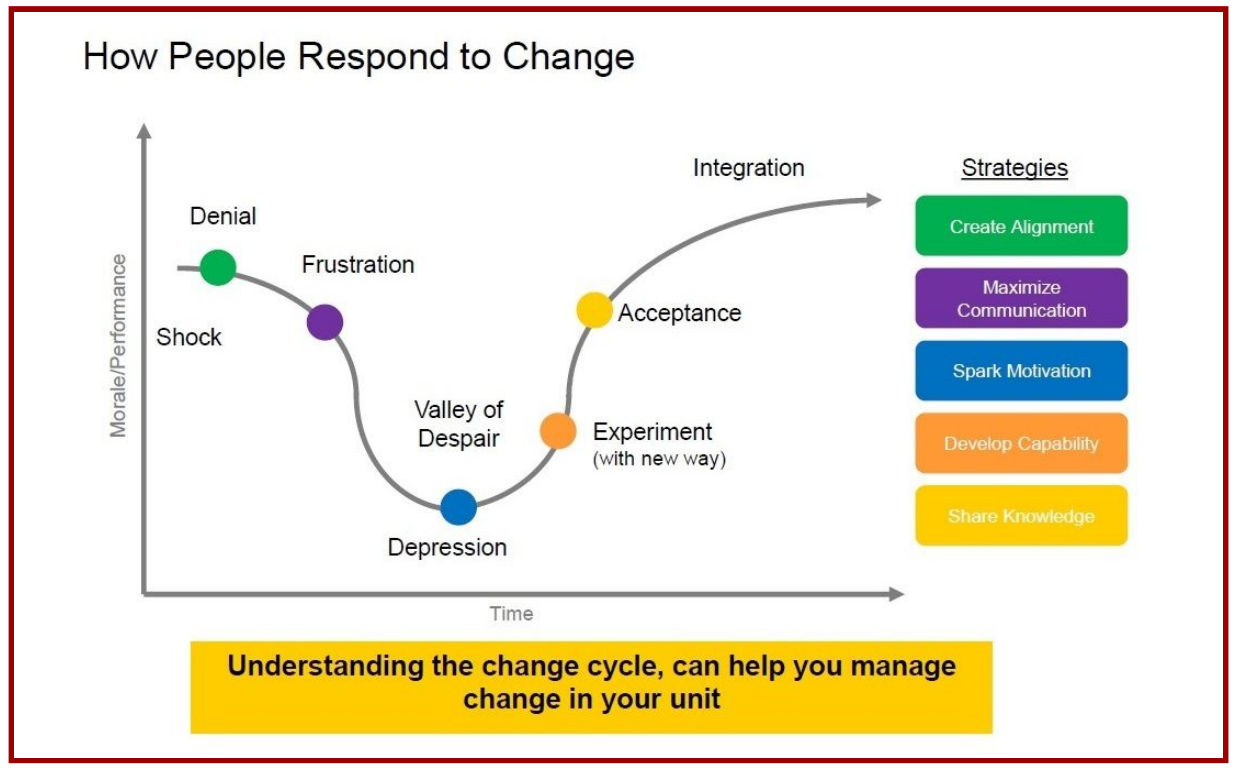
We need to empathise, listen , giving patient hearing, support, counselling, coaching, confidence building workshop to get impacted audiences out of negative emotional stages and move toward positive & looking forward attitude.
Step 04 - Identifying actions for and by the audience
Next we need to identify actions required for and by the audiences. We need to understand what does each audience group need in order to be ready, willing and able to embrace the change? For example the relationship manager needs to participant in the customer focus group so they can “validate the change”.
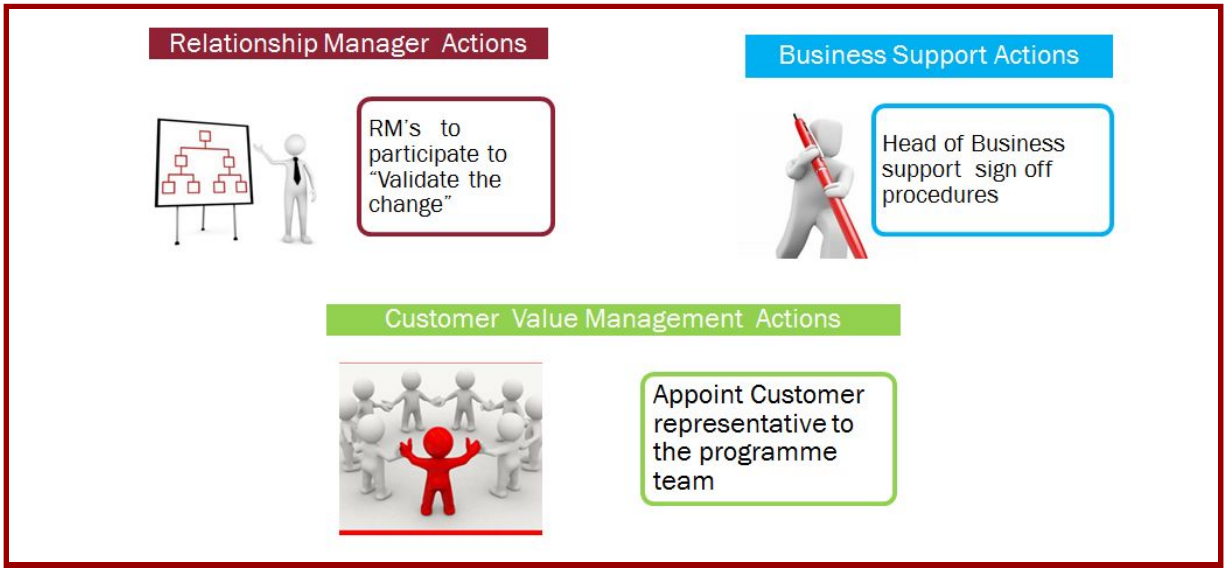
Also what does the programme team expect or require from the audience group to make it successful to avoid resistance or delays? For example Head of business support to sign off procedures by end of Definition stage. The programme team may also have actions assigned to them . For example Customer Value Management wants someone from their management team to be appointed to the programme team because they have the best understanding of what the change means and how to best implement it.
Programme team would have action to Assigning change champion for each audience group and train the trainer. Throughout the programme, there would be many actions from various sources and people, this audience analysis process is a great way to capture them centrally. We need actions which they will perform as part of activities while implementing and embedding the change.
Step 05 - Establish an Assign change interventions to audience groups
Once we understand the audience impacts, reaction, preferences and actions, we need to identify their change interventions required to mitigate any potential resistance and to build their commitment to the change. This is time consuming and the recommendation is have face to face workshop to conclude this.
As a starting point :
1.We need to establish the starting point and desired end point for each audience on the change curve
2.We need to think about the change ’path’ each audience will go along. What will they experience? How will it feel for them travelling along that path?
3. Establish appropriate change interventions required to mitigate any potential resistance or areas of concern so you can build commitment to the change
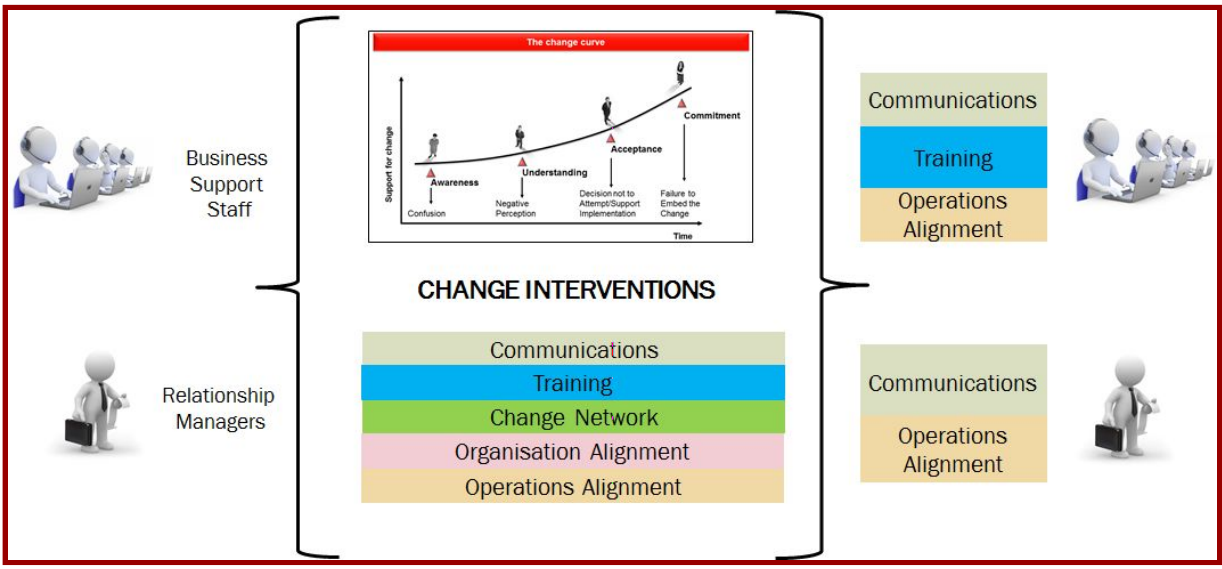
Let’s go through an example using the business support staff . Today, they are not aware of the programme so you need to start at awareness level. Their desired end state should be “committed” to the change. They will must accept why the operations process is changing, able to follow the new process and adopt their new responsibilities on Go-live date. They may experience relief at stopping manual tasks but feel loss of no onsite support or fear of learning a new system and concern about running parallel process whilst you embed the new change. In this example, the best change interventions are communications, training and operational alignment. A consequence of not engaging with them at this time is “confusion”. They may hear things but not formally and start to draw their own conclusions. The key is to build up knowledge and awareness through meeting, briefs and regular engagement & communication. A consequence of not building up their knowledge and awareness will result in “negative perception” and there would be loss of support from them for the programme.
Audience Analysis – Feed into Implementation
Contribute to Business Implementation activities & artefacts.
Firstly throughout the process , we need to document audience analysis finding, recommendation, ongoing actions, risk and issues, success factors, metrics and performance indicators. You could devise an appropriate template and store at a central location so that all relevant parties could get access to it and individual working on other activities could take this into their consideration while creating their artefacts such as impact assessment document, communication & training plan, implementation /deployment approach, business readiness plan , benefit realisation plan, process modelling so on so forth. For example, training needs per audience group would eventually go into your training approach and plan and identified change interventions need to be incorporated into change
implementation plan. In my experience, we created an appropriate template using tool confluence which accessed by all involved in the programme. As it is iterative and continuous process , you need to go back & forth with audience groups to accommodate
any amendment/ new finding , it is ideal to have it in central location to avoid multiple versions are flying around.A summary pack is essential to apprise senior stakeholder, in PWG, sterco or adhoc meetings.
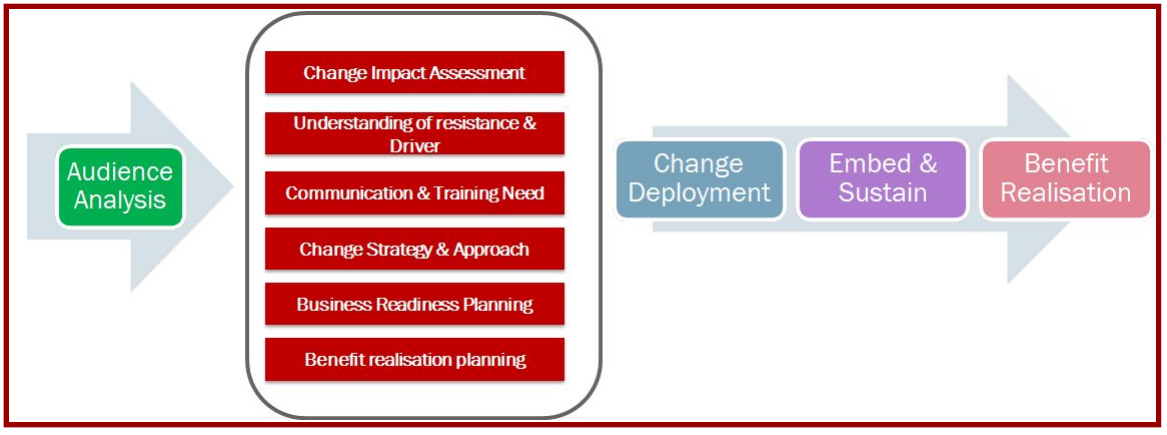
Recommendations:
- keep it simple – avoid creating unnecessary cost or over complicating the plan. in general you need to balance audience specific interventions with not over complicating the plan and not creating unnecessary cost.
- Think scalability and repeatability – look for opportunity to ‘develop once, then customise by audiences’. Whenever possible , any change intervention should be readily adaptable for different audiences, and easily adapted by smaller or larger groups.
- Keep Reviewing with programme stakeholders and key business stakeholders and keep updating them through project working group meeting –so that any feedback or steer gets considered. Factor in time cost when adopting any particular change intervention.
Conclusion
I hope I am able to justify in answering why Audience Analysis is important , how it could be done and what & how it contributes towards a successful business change implementation.
Author : Ravi Kumar
